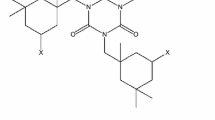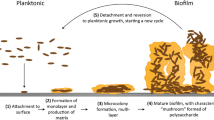Abstract
An assay has been developed to accurately quantify the growth and release behaviour of bacterial biofilms on several test reference materials and coatings, using the marine bacterium Cobetia marina as a model organism. The assay can be used to investigate the inhibition of bacterial growth and release properties of many surfaces when compared to a reference. The method is based upon the staining of attached bacterial cells with the nucleic acid-binding, green fluorescent SYTO 13 stain. A strong linear correlation exists between the fluorescence of the bacterial suspension measured (RFU) using a plate reader and the total bacterial count measured with epifluorescence microscopy. This relationship allows the fluorescent technique to be used for the quantification of bacterial cells attached to surfaces. As the bacteria proliferate on the surface over a period of time, the relative fluorescence unit (RFU) measured using the plate reader also shows an increase with time. This was observed on all three test surfaces (glass, Epikote and Silastic T2) over a period of 4 h of bacterial growth, followed by a release assay, which was carried out by the application of hydrodynamic shear forces using a custom-made rotary device. Different fixed rotor speeds were tested, and based on the release analysis, 12 knots was used to provide standard shear force. The assay developed was then applied for assessing three different antifouling coatings of different surface roughness. The novel assay allows the rapid and sensitive enumeration of attached bacteria directly on the coated surface. This is the first plate reader assay technique that allows estimation of irreversibly attached bacterial cells directly on the coated surface without their removal from the surface or extraction of a stain into solution.







Similar content being viewed by others
References
Akesso L, Pettitt ME, Callow JA, Callow ME, Stallard J, Teera D, Liu C, Wang S, Zhao Q, D’Souza F, Willemsen PR, Donnelly GT, Donik C, Kocijan A, Jenko M, Jones LA, Guinaldo PC (2009) The potential of nano-structured silicon oxide type coatings deposited by PACVD for control of aquatic biofouling. Biofouling 25:55–67
American society of testing materials (2007) Standard test method for subjecting marine antifouling coating to biofouling and fluid shear forces in natural seawater. D4939–89
Anderson CA, Atlar M, Callow M, Candries M, Milne A, Townsin RL (2003) The development of foul-release coatings for seagoing vessels. J Mar Des Oper Part B4 11–23
Arnold JW (2008) Colorimetric assay for biofilms in wet processing conditions. J Ind Microbiol Biotechnol 35:1475–1480
Baier RE (1980) Substrate influences on adhesion of microorganisms and their resultant new surface properties. In: Bitton G, Marshall KC (eds) Adsorption of microorganisms to surfaces. Wiley, New York, pp 59–104
Balkwill DL, Murphy EM, Ringelberg DB, White DC (1988) Microbial communities in high and low recharge environments: implications for microbial transport in the vadose zone. Microbial Ecol 35:156–171
Barnes LM, Lo MF, Adams MR, Chamberlain AHL (1999) Effect of milk proteins on adhesion of bacteria to stainless steel surfaces. Appl Environ Microbiol 65:4543–4548
Bers AV, D’Souza F, Klijnstra JW, Willemsen PR, Wahl M (2006) Chemical defence in mussels: antifouling effect of crude extracts of the periostracum of the blue mussel Mytilus edulis. Biofouling 22:251–259
Bhosle NB, Garg A, Fernandes L, Citon P (2005) Dynamics of amino acids in the conditioning film developed on glass panels immersed in surface seawaters of the Dona Paula Bay. Biofouling 21:99–107
Brady RF Jr (2001) A fracture mechanical analysis of fouling release from nontoxic antifouling coatings. Prog Org Coatings 43:188–192
Braind JF (2009) Marine antifouling laboratory bioassays: an overview of their diversity. Biofouling 25:297–311
Burton E, Yakandawala N, Lo Vetri K, Madhyastha MS (2007) A microplate spectrofluorometric assay for bacterial biofilms. J Ind Microbiol Biotechnol 34:1–4
Cassé F, Stafslien SJ, Bahr JA, Daniels J, Finlay JA, Callow JA, Callow ME (2007) Combinatorial materials research applied to the development of new surface coatings V. Application of a spinning water-jet for the semi-high throughput assessment of the attachment strength of marine fouling algae. Biofouling 23:121–130
Cordeiro AL, Nitschke M, Janke A, Helbig R, D’Souza F, Donnelly GT, Willemsen PR, Werner C (2009) Fluorination of poly(dimethylsiloxane) surfaces by low pressure CF4 plasma–physicochemical and antifouling properties. eXPRESS Polymer Letters 3:70–83
Dobretsov S, Dahms HU, Qian PY (2006) Inhibition of biofouling by marine microorganisms and their metabolites. Biofouling 22:43–54
Ekblad T, Bergstro MG, Ederth T, Conlan SL, Mutton R, Clare AS, Su Wang, Liu Y, Zhao Q, D’Souza F, Donnelly GT, Willemsen PR, Pettitt ME, Callow ME, Callow J, Liedberg B (2008) Poly(ethylene glycol)-containing hydrogel surfaces for antifouling applications in marine and freshwater environments. Biomacromolecules 9:2775–2783
Finlay JA, Callow ME, Schultz MP, Swain GW, Callow JA (2002) Adhesion strength of settled spores of the green alga Enteromorpha. Biofouling 18:251–256
Ford TE, Walch M, Mitchell R, Kaufman MJ, Vestal JR, Ditner SA, Lock MA (1989) Microbial film formation on metals in an enriched Artic river. Biofouling 1:302–317
Garg A, Jain A, Bhosle NB (2009) Chemical characterization of the marine conditioning film. Int Biodeterior Biodegrad 63:7–11
Hannig C, Hannig M, Rehmer O, Braun G, Hellwig E, Al-Ahmad A (2007) Fluorescence microscopic visualization and quantification of initial bacterial colonization on enamel in situ. Arch Oral Biol 52:1048–1056
Holmstrom C, Kjelleberg S (1994) The effect of external biological factors on settlement of marine invertebrate and new antifouling technology. Biofouling 8:147–160
Honraet K, Nelis HJ (2006) Use of the modified Robbins device and fluorescent staining to screen plant extracts for the inhibition of S. mutans biofilm formation. J Microbiol Methods 64:217–224
Kavanagh CJ, Quinn RD, Swain GW (2005) Observations of barnacle detachment from silicones using high-speed video. J Adhesion 81:843–868
Leriche V, Sibille P, Carpenter B (2000) Use of an enzyme-linked lectinsorbent assay to monitor the shift in polysaccharide composition in bacterial biofilms. Appl Environ Microbiol 66:1851–1856
Leroy C, Delbarre-Ladrat C, Ghillebaert F, Rochet MJ, Compere C, Combes D (2008) Effects of commercial enzymes on the adhesion of a marine biofilm-forming bacterium. Biofouling 24:11–22
Leroy C, Delbarre-Ladrat C, Ghillebaert F, Rochet MJ, Compere C, Combes D (2007) A marine bacterial adhesion microplate test using the DAPI fluorescent dye: a new method to screen antifouling agents. Lett Appl Microbiol 44:372–378
Loeb GI, Neihof RA (1977) Adsorption of an organic film at a platinum seawater interface. J Mar Res 35:283–291
Nancharaiah YV, Venugopalan VP, Wuertz S, Wilderer PA, Hausner M (2005) Compatibility of the green fluorescent protein and a general nucleic acid stain for quantitative description of a Pseudomonas putida biofilm. J Microbiol Methods 60:179–187
Paul JH, Myers B (1982) Fluorometric determination of DNA in aquatic microorganisms by using of Hoechst 33258. Appl Environ Microbiol 43:1393–1399
Rentrop C, Wouters M, D’Souza F, Donnelly G, Willemsen P (2008) Antifouling without biocides: how surface structure of hybrid coatings affects bioadhesion. Eur Coat J 10
Schultz MP (2007) Effects of coating roughness and biofouling on ship resistance and powering. Biofouling 23:331–341
Schultz MP, Finlay JA, Callow ME, Callow JA (2000) A turbulent channel flow apparatus for the determination of the adhesion strength of microfouling organisms. Biofouling 15:243–251
Sonak S, Bhosle NB (1995) Observations on biofilm bacteria isolated from aluminium panels immersed in estuarine waters. Biofouling 8:234–254
Stafslien S, Daniels J, Bret M, Christianson D, Chisholm B, Abdullah E, Webster D, Swain G (2007) Combinatorial materials research applied to the development of new surface coatings IV. A high-throughput bacterial biofilm retention and retraction assay for screening fouling-release performance of coatings. Biofouling 23:45–54
Stafslien SJ, Bah JA, Daniels JW, Wal LV, Nevins J, Smith J, Schiele K, Chisholm B (2007) Combinatorial materials research applied to the development of new surface coatings. VI. An automated spinning water jet apparatus for the high-throughput characterization of fouling-release marine coatings. Rev Sci Instrum 78:1–6
Statz A, Finlay J, Dalsin J, Callow ME, Callow JA, Messersmith PB (2006) Algal antifouling and fouling-release properties of metal surfaces coated with a polymer inspired by marine mussels. Biofouling 22:391–399
Swain GW, Schultz MP (1996) The testing and evaluation of nontoxic antifouling coatings. Biofouling 10:187–197
Tang RJ, Cooney JJ (1998) Effects of marine paints on microbial biofilm development on three materials. J Ind Microbiol Biotechnol 20:275–280
Tang Y, Finlay JA, Kowalke GL (2005) Hybrid xerogel films as novel coating for antifouling and fouling release. Biofouling 21(1):59–71
Vandevivere P, Kirchman DL (1993) Attachment stimulates exopolysaccharide synthesis by a bacterium. Appl Environ Microbiol 59:3280–3286
Wendt DE, Kowalke GL, Kim J, Singer IL (2006) Factors that influence coatings performance: the effect of coating thickness on basal plate morphology, growth and critical removal stress of the barnacle Balanus amphitrite. Biofouling 22:1–9
Wieczorek KS, Todd DC (1998) Inhibition and facilitation of settlement of epifaunal marine invertebrate larvae by microbial biofilm cues. Biofouling 12:81–117
Acknowledgments
The authors acknowledge support from the AMBIO Integrated Project (NMP-CT-2005-011827) funded by the European Commission’s 6th Framework Programme.
Author information
Authors and Affiliations
Corresponding author
Rights and permissions
About this article
Cite this article
D’Souza, F., Bruin, A., Biersteker, R. et al. Bacterial assay for the rapid assessment of antifouling and fouling release properties of coatings and materials. J Ind Microbiol Biotechnol 37, 363–370 (2010). https://doi.org/10.1007/s10295-009-0681-1
Received:
Accepted:
Published:
Issue Date:
DOI: https://doi.org/10.1007/s10295-009-0681-1




